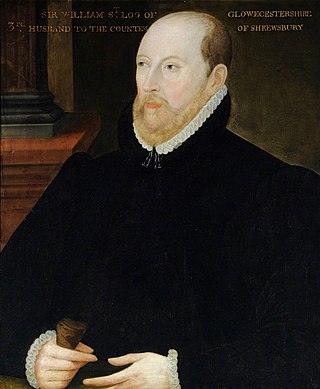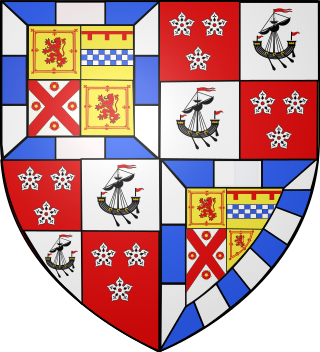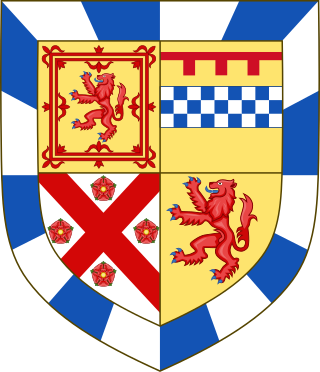
Andrew Stewart, 2nd Lord Ochiltree (c. 1521–1591) fought for the Scottish Reformation. His daughter married John Knox and he played a part in the defeat of Mary, Queen of Scots at the battle of Langside.

Andrew Stewart, 2nd Lord Ochiltree (c. 1521–1591) fought for the Scottish Reformation. His daughter married John Knox and he played a part in the defeat of Mary, Queen of Scots at the battle of Langside.
Andrew's father, Andrew Stewart, 2nd Lord Avondale, exchanged his lands and title to become Lord Ochiltree.
Lord Ochiltree became a Protestant when Scotland was still a Catholic country. When resistance to the Catholic religion and the rule of the Regent of Scotland, Mary of Guise, began to grow, Ochiltree was one of the first of the Lords of the Congregation who marched to Perth in June 1559, and joined up with the rest at Edinburgh by 1 July. Ochiltree was a signatory to the Congregation's letters to Elizabeth I of England and William Cecil on 19 July 1559. John Knox wrote the letters, which state their "whole intent" was to remove superstition and "maintain the liberty this our country from the tyranny and thraldom of strangers." Cecil replied mentioning the example of the polity of Denmark, and wondering what place the Hamiltons, the former Duke of Châtelherault, the Earl of Arran and Lord David Hamilton might have in their scheme. [2]
On 27 April 1560, Ochiltree signed the "Band of the Scottish Nobility", which pledged to expel French troops from Scotland and assist the English army, which had entered Scotland under the terms of the Congregation's Treaty of Berwick. [3] John Knox later wrote in his History of the Reformation in Scotland that Ochiltree was "a man more likely to look for peace than fight in the causeway."
Lord Ochiltree's daughter Margaret married John Knox in 1563. His second son James Stewart became the powerful Earl of Arran in the 1580s. His eldest son Andrew, Master of Ochiltree, died before him, in 1578. The Master of Ochiltree's wife Margaret, Mistress of Ochiltree, was an important royal servant, and at least three of her daughters were ladies in waiting to Anne of Denmark. [4]
Lord Ochiltree died in November 1591. [5] He was succeeded by his grandson, Andrew, 3rd Lord Ochiltree, who later became Andrew Stuart, 1st Baron Castle Stuart.
Andrew Stewart, 2nd Lord Ochiltree married Agnes Cunningham of the Caprington family. Their children, and grandchildren included;
Andrew Stewart, 2nd Lord Ochiltree married secondly, Margaret Cunningham, daughter of Alexander Cunningham, 5th Earl of Glencairn, and widow of John Wallace of Craigie. [15]
Andrew 2nd Lord Ochiltree seems to have had a son with Janet Forbes, John Stewart or Stuart. He entered the service of Sweden and was master of horse to Eric XIV, [16] and had two sons Andrew and John. This branch of the Ochiltree family is introduced at the Swedish House of Lords (Riddarhuset) under the name Stuart. Hans (Johannes) Stuart (d. 1618) obtained a letter of descent in Edinburgh in 1579 and a letter of arms at Holyrood Castle in Edinburgh from King James VI of Scotland in 1585
John Stuart married Brita Eriksdotter Soop, and their daughter Martha Stuart (1606-1653) married a French lieutenant-colonel, Anton Ydron, who was killed at the battle of Nürnberg in 1632 in the Thirty Years' War (1618–48). As a widow Martha Stuart lived on the island of Almö, and was a frequent correspondent of the Swedish chancellor, Axel Oxenstierna, whose castle Tidö Slott was nearby. [17]

Earl Castle Stewart, in the County Tyrone, is a title in the Peerage of Ireland. It was created in 1800 for Andrew Thomas Stewart, 9th Baron Castle Stuart.

Matthew Stewart, 4th Earl of Lennox was a leader of the Catholic nobility in Scotland. He was the paternal grandfather of King James VI of Scotland. He owned Temple Newsam in Yorkshire, England.

James Hamilton, 1st Earl of Arran and 2nd Lord Hamilton was a Scottish nobleman, naval commander and first cousin of James IV of Scotland. He also served as the 9th Lord High Admiral of Scotland.

Henry Stewart, 1st Lord Methven was Master of the Scottish Artillery and third, and last husband, of Margaret Tudor, eldest daughter of Henry VII of England and Elizabeth of York.

Captain James Stewart, Earl of Arran was created Earl of Arran by the young King James VI, who wrested the title from James Hamilton, 3rd Earl of Arran. He rose to become Lord Chancellor of Scotland and was eventually murdered in 1595.

Andrew Stewart, 2nd Lord Avondale or Andrew Stuart, 1st Lord Ochiltree, was a Scottish peer.

Andrew Stewart, 1st Baron Castle Stuart (1560–1629) was a Scottish nobleman, soldier, courtier to King James VI and I and one of the chief undertakers in the Ulster Plantation. Stuart resigned his title "Lord Ochiltree" and was made "Baron Castle Stuart".
James Stewart, 4th Lord Ochiltree was a 17th-century Scottish noble.
Gilbert Kennedy of Bargany and Ardstinchar was a Scottish landowner and murder victim. Kennedy had inherited a long-standing family feud with John Kennedy, 5th Earl of Cassilis, on the death of his father, Thomas Kennedy of Bargany. On 11 December 1601 he met the Earl and his followers at Pennyglen near Maybole and was murdered with a lance thrust in his back.
Margaret Stewart, Mistress of Ochiltree was a courtier in the household of Anne of Denmark in Scotland and looked after her children Prince Henry, Princess Elizabeth, and Charles I of England

Jean Stewart, Lady Bargany was a Scottish lady in waiting to Anne of Denmark. She was a younger daughter of Andrew, Master of Ochiltree and Margaret Stewart, Mistress of Ochiltree. Jean was a maiden in the household of Anne of Denmark and her mother was the senior lady in waiting. Her marriage is of special interest to historians.
Andrew Keith, Lord Dingwall was a Scottish landowner, soldier, and diplomat.
James Stewart, 1st Lord Doune (1529-1590) was a Scottish landowner.
Elizabeth Stewart, Countess of Arran was a Scottish aristocrat and political intriguer. Several accounts of her actions and ambition were written by her political enemies.
William Stewart of Monkton and Carstairs was a Scottish landowner and courtier.
Thomas Kennedy of Bargany was a Scottish courtier and landowner.
Thomas Kerr of Ferniehirst was a Scottish landowner, Roman Catholic and supporter of Mary, Queen of Scots. He and Jean Scott ended the feud between the Scott family and the Kerrs. Thomas and Jean were both involved with supporting Mary, Queen of Scots.
Janet or Jean Scott, Lady Ferniehirst was a Scottish landowner. She was a member of the Border family of Scott who succumbed to an arranged marriage that healed the feud with the family who killed her father. Her marriage to Thomas Kerr of Ferniehirst was successful and she took a role in Scottish politics between the Scottish court and the exiled Mary, Queen of Scots.

Dorothea Stewart, Countess of Gowrie was a Scottish aristocrat. The dates of the birth and death of Dorothea Stewart are unknown.
Janet Stewart was a Scottish aristocrat.